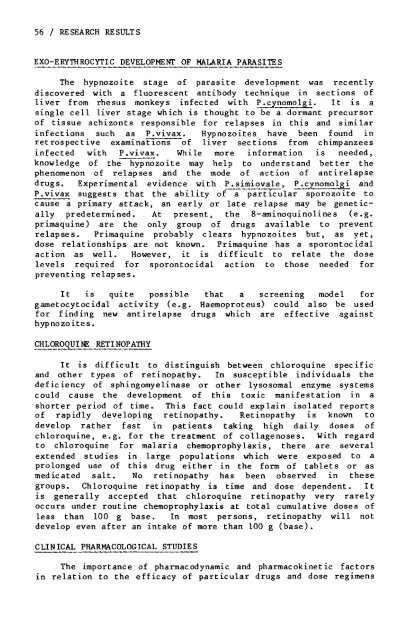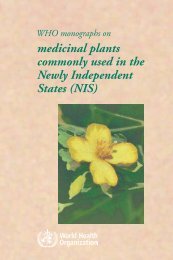Drug-Resistant Malaria - libdoc.who.int - World Health Organization
Drug-Resistant Malaria - libdoc.who.int - World Health Organization
Drug-Resistant Malaria - libdoc.who.int - World Health Organization
Create successful ePaper yourself
Turn your PDF publications into a flip-book with our unique Google optimized e-Paper software.
56 / RESEARCH RESULTS<br />
EXO-ERYTHROCYTIC DEVELOPMENT OF MALARIA PARASITES<br />
The hypnozoite stage of parasite development was recently<br />
discovered with a fluorescent antibody technique in sections of<br />
liver from rhesus monkeys infected with ~'y'nomolgi. It 1S a<br />
single cell liver stage which is thought to be a dormant precursor<br />
of tissue schizonts responsible for relapses in this and simi lar<br />
infections such as P.vivax. Hypnozoites have been found in<br />
retrospective examinat10ns of liver sections from chimpanzees<br />
infected with P.vivax. While more information is needed,<br />
knowledge of the hypnozoite may help to understand better the<br />
phenomenon of relapses and the mode of action of antirelapse<br />
drugs. Experimental evidence with P.simiovale, P.cynomolgi and<br />
P.vi~ suggests that the ability ofa particular sporozoite to<br />
cause a primary attack, an early or late relapse may be genetically<br />
predetermined. At present, the 8-aminoquinolines (e.g.<br />
primaquine) are the only group of drugs available to prevent<br />
relapses. Primaquine probably clears hypnozoites but, as yet,<br />
dose relationships are not known. Primaquine has a sporontocidal<br />
action as well. However, it is difficult to relate the dose<br />
levels required for sporontocidal action to those needed for<br />
preventing relapses.<br />
It is quite possible that a screening model for<br />
gametocytocidal activity (e.g. Haemoproteus) could also be used<br />
for finding new antirelapse drugs which are effective against<br />
hypnozoites.<br />
CHLOROQUINE RETINOPATHY<br />
It 1S difficult to distinguish between chloroquine specific<br />
and other types of retinopathy. In susceptible individuals the<br />
defic iency of sphingomyelinase or other lysosomal enzyme systems<br />
could cause the development of this toxic manifestation 1n a<br />
shorter period of time. This fact could explain isolated reports<br />
of rapidly developing retinopathy. Retinopathy is known to<br />
develop rather fast in patients taking high daily doses of<br />
chloroquine, e.g. for the treatment of collagenoses. With regard<br />
to chloroquine for malaria chemoprophylaxis, there are several<br />
extended studies in large populations which were exposed to a<br />
prolonged use of this drug either in the form of tablets or as<br />
medicated salt. No retinopathy has been observed 1n these<br />
groups. Chloroquine ret inopathy is time and dose dependent. It<br />
is generally accepted that chloroquine retinopathy very rarely<br />
occurs under routine chemoprophylaxis at total cumulative doses of<br />
less than 100 g base. In most persons, retinopathy will not<br />
develop even after an <strong>int</strong>ake of more than 100 g (base).<br />
CLINICAL PHARMACOLOGICAL STUDIES<br />
The importance of pharmacodynamic and pharmacokinet ic factors<br />
1n relation to the efficacy of particular drugs and dose regimens
















